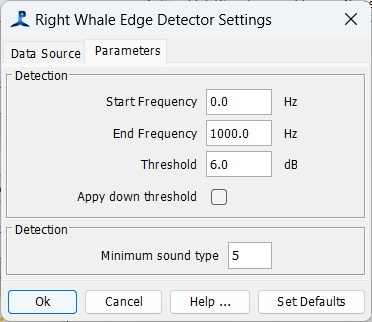Configuration
The detector was designed to process data sampled at 2kHz, and then pre-processed with an FFT with length 256 samples, with a 50% (128 sample) overlap. If your data were not collected at 2kHz sample rate, then use a Decimator module to adjust the data sample rate.
Configure the FFT
The ratio of the FFT length to the sample rate is important, since it sets the time and frequency resolution of the spectrogram image that feeds the detector. A sample rate of 2kHz these FFT settings give a frequency resolution of 7.8Hz and a time step of 64ms, which is ideal for detecting Right Whale upsweeps that are typically between 100 and 200Hz, and have a duration of 0.5 to 1.0s.
Noise Removal
The FFT module has several options for noise reduction. The Right Whale Edge Detector uses just one of these: the Gaussian Smoothing Kernel. It doesn’t matter whether this is enabled or not in the FFT module since the Right Whale Edge Detector will check if it’s been run on the data, and implement it anyway if it hasn’t.
Configure the detector
Once you’ve correctly configured the FFF open the Right Whale dialog from the Settings menu


Data Source
Select the correct FFT data source (you may have more than one) and which channels of data you want to process. These will be processed independently of one another.
Parameters
Generally the start and end frequencies for the search can be left at 0 and 1000 Hz, though you can set them a bit differently if you’ve interfering noise sources at very high or low frequencies.
Threshold is the threshold in dB above which sounds are detected. The defaults is 6dB.
Apply down threshold modifies the search algorithm from Gillespie 2004 slightly so that the outline of the sound is determined as the point where it drops the threhsold number of dB below the sounds maximum, rather than taking the outline of the sound as any data threshold dB above the background.
Min Sound Type is a quality flag to determine how “right whale like” a sound must be before it is recorded that can have a value between 1 and 12. Generally, only sounds with a sound type greater than 9 are likely to be from right whales, though you might want to record lower quality sounds to check manually.